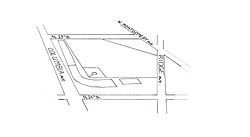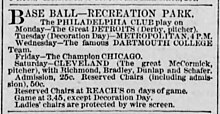
The Polo Grounds was the name of three stadiums in Upper Manhattan, New York City, used mainly for professional baseball and American football from 1880 through 1963. The original Polo Grounds, opened in 1876 and demolished in 1889, was built for the sport of polo. Bound on the south and north by 110th and 112th streets and on the east and west by Fifth and Sixth (Lenox) avenues, just north of Central Park, it was converted to a baseball stadium when leased by the New York Metropolitans in 1880.

National League Park, commonly referred to as the Baker Bowl after 1923, was a baseball stadium and home to the Philadelphia Phillies from 1887 until 1938, and first home field of the Philadelphia Eagles from 1933 to 1935. It opened in 1887 with a capacity of 12,500, burned down in 1894, and was rebuilt in 1895 as the first ballpark constructed primarily of steel and brick, and first with a cantilevered upper deck. The ballpark's first base line ran parallel to Huntingdon Street; right field to center field parallel to N Broad Street; center field to left field parallel to Lehigh Avenue; and the third base line parallel to 15th Street. The stadium was demolished in 1950.

Columbia Park or Columbia Avenue Grounds was a baseball park in Philadelphia. It was built in 1901 as the first home of the Philadelphia Athletics, who played there for eight seasons, including two games of the 1905 World Series.

Exposition Park was the name given to three historic stadiums, located in what is today Pittsburgh, Pennsylvania. The fields were used mainly for professional baseball and American football from c. 1879 to c. 1915. The ballparks were initially located on the north side of the Allegheny River in Allegheny City, Pennsylvania. The city was annexed into Pittsburgh in 1907, which became the city's North Side, located across from Pittsburgh's downtown area. Due to flooding from the nearby river, the three stadiums' exact locations varied somewhat. The final version of the ballpark was between the eventual sites of Three Rivers Stadium and PNC Park.
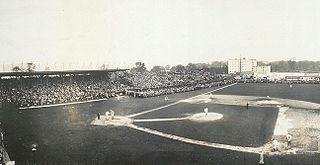
Hilltop Park was the nickname of a baseball park that stood in the Washington Heights neighborhood of New York City. It was the home of the New York Yankees of Major League Baseball from 1903 to 1912, when they were known as the "Highlanders". It was also the temporary home of the New York Giants during a two-month period in 1911 while the Polo Grounds was being rebuilt after a fire.
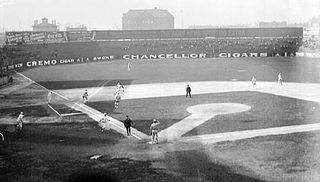
South Side Park was the name used for three different baseball parks that formerly stood in Chicago, Illinois, at different times, and whose sites were all just a few blocks away from each other.
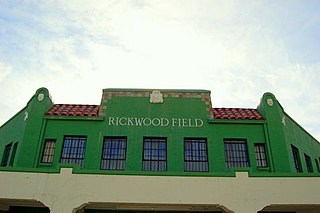
Rickwood Field, located in Birmingham, Alabama, is the oldest professional baseball park in the United States. It was built for the Birmingham Barons in 1910 by industrialist and team-owner Rick Woodward and has served as the home park for the Birmingham Barons and the Birmingham Black Barons of the Negro leagues. Though the Barons moved their home games to the Hoover Met in the suburbs, and most recently to Regions Field in Birmingham, Rickwood Field has been preserved and is undergoing gradual restoration as a "working museum" where baseball's history can be experienced. The Barons also play one regular season game a year at Rickwood Field. Rickwood Field is listed on the National Register of Historic Places.
23rd Street Grounds, also known as State Street Grounds and 23rd Street Park, and sometimes spelled out as Twenty-third Street Grounds, was a ballpark in Chicago, in what is now the Chinatown district. In this ballpark, the Chicago White Stockings played baseball from 1874 to 1877, the first two years in the National Association and the latter two in the National League.
Jefferson Street Grounds was a baseball field located in Philadelphia, Pennsylvania. It was also known as Jefferson Park and Athletics Park. It was home to three different professional baseball teams, competing in three different leagues. Notably, it was the venue for the first game in National League history, played on April 22, 1876.

Sulphur Dell, formerly known as Sulphur Spring Park and Athletic Park, was a baseball park in Nashville, Tennessee, United States. It was located just north of the Tennessee State Capitol building in the block bounded by modern-day Jackson Street, Fourth Avenue North, Harrison Street, and Fifth Avenue North. The ballpark was home to the city's minor league baseball teams from 1885 to 1963. The facility was demolished in 1969.
League Park was a Major League baseball park located in Cincinnati, Ohio, United States. It was the home of the Cincinnati Reds from 1884 through 1901. The ballpark was on an asymmetrical block bounded by Findlay Street (south), Western Avenue, York Street (north) and McLean Avenue (west).

John Francis Coleman was an American professional baseball outfielder and pitcher. He played in Major League Baseball (MLB) for the Philadelphia Quakers, Philadelphia Athletics, and Pittsburgh Alleghenys from 1883 to 1890. Coleman holds the MLB single-season record for pitching losses, with 48.
The 1883 season was the first in the history of the Philadelphia Quakers. The team was founded earlier in the year as a replacement for the Worcester franchise. It was the first year Philadelphia was represented in the National League since the original Athletics were disbanded in 1876. The American Association's Philadelphia Athletics had been founded a year earlier.
The P.R.R. YMCA Athletic Field, also known as Penmar Park and commonly referred to in the 1930s and 1940s as the 44th and Parkside ballpark, was an athletic field and ballpark in West Philadelphia from as early as the 1890s to the early 1950s. It was built by the Pennsylvania Railroad YMCA for use by its employees. Behind the right-field fence stood the roundhouse of the main yard of the Pennsylvania Railroad. The Negro league baseball Philadelphia Stars played home games at the park from 1936 until 1952.

Clearwater Athletic Field was a stadium in Clearwater, Florida. It was first used by professional baseball teams for spring training in 1923 and was the Phillies' first spring training ballpark in Clearwater. The grandstand sat approximately 2,000 and bleachers increased capacity to close to 3,000. Home plate was located on Pennsylvania Avenue, which ran south to north along the third base line, near Seminole Street. Left field ran parallel to Palmetto Street, and right field ran parallel to Greenwood Ave. The grandstand was destroyed by fire in April 1956.

Flamingo Field was a ballpark at the corner of 15th Street and Michigan Avenue in Miami Beach, Florida, home to Miami Beach minor-league clubs and the spring training home of the New York Giants in 1934 and 1935, the Philadelphia Phillies from 1940 to 1942, and again in 1946, and the Pittsburgh Pirates in 1947. Capacity was approximately 3,000 for baseball. The center field fence was 386 feet from homeplate. The park was also referred to as "Flamingo Park", which is also the name of the area in which it was located.

Oriole Park, often referred to as Terrapin Park, opened in 1914 and closed after a fire on July 3–4, 1944. "Oriole Park" was the name of multiple baseball parks in Baltimore, Maryland, all built within a few blocks of each other.
Athletic Grounds was a baseball field located in Philadelphia, Pennsylvania during the 1860s. It was the first home of the Philadelphia Athletics (1860-1876). It was often called the grounds at 15th and Columbia.
